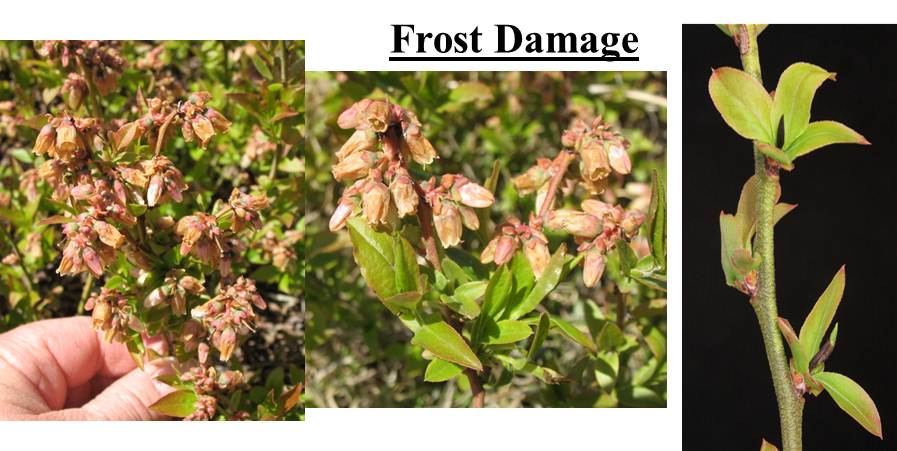Cold temperatures in Midcoast and some Downeast fields overnight from May 17 to 18, 2023
We had cold conditions reported at our blueberry weather stations mostly in the Midcoast area and colder fields Downeast. The weather stations are only in one spot in a field and will not reflect what has happened in that entire field or other fields nearby. In the Midcoast, we had weather conditions that may kill flowers and cause problems with fruit set. Temperatures around 30°F may cause some browning of flowers but not too much damage to the fruit. Temperatures at or below 28°F are the most damaging to wild blueberry plants and we did have some fields with prolonged cold temperatures last night (Please see table below). More information on damage to blueberries from cold temperatures can be found below.
Temperature conditions overnight from May 17 to May 18, 2023
| Location | Coldest Temperature | Length of Cold in F |
| Waldoboro | 25 F | below 28F for about 2.5hr |
| W. Rockport | 28 F | at 28F for about 1hr |
| Appleton | 24F | below 26F for about 3 hours |
| Liberty | 24 F | below 28F for about 3hr |
| Searsport | not working | |
| Ellsworth | 29 F | less than 30 F for about 1 hr |
| Eastbrook | 29 F | less than 30 F for at least 1 hr, missing data from 6:40am to 9am |
| Blue hill/ Sedgewick | 29 F | less than 30 F for about 1 hr |
| Aurora | 26 F | less than 28F for about 1/2 hour |
| Steuben | did not drop below 32 F | |
| Deblois | 1am 28 F and 5am 26F | field was irrigated for frost protection so our sensor did not drop below 30F |
| Montegail | not working | |
| BBHF, Jonesboro | 28 F | at 28F for about 2hr |
| Whiting/E. Machias | 30F | at 30F for about 1 hr |
| Crawford | 30 F | at 30 F for about 1/2 hr |
Frost events can damage flowers visibly by browning the flower (picture at bottom), but also internally. Internal damage may not appear until after fruit set when a lack of fruit development is observed. You can check the green fruit in your field for frost damage by cutting fruit open. Undamaged berries will be green inside, while damaged berries will be brown inside. Damage will vary depending on local conditions in your field and the stage that the wild blueberry plants were in when cold temperatures occurred. Typically, lower sections of fields experience more frost damage than higher points. According to research conducted in Nova Scotia, wild blueberry flowers and leaves have the following effects from exposure to cold temperatures (see table below). Open flowers are more susceptible to freezing damage than closed flowers. Freezing temperatures can also affect whether or not closed flowers will open. The colder temperatures are, the more likely it is that fruit set will be damaged, regardless of the length of time that it is cold.
Temperature effects on wild blueberry flowers and leaves according to Hall et al. 1971, Hall and Hildebrand, 1988, and Hicklenton et al., 2002.
| Temperature | Damage |
| 30.5°F | Slight injury to flowers, little effect on fruit set, occasional necrosis at edges of leaves |
| 28 °F | Greater than 2 hours, 40 to 60% loss of fruit set in open flowers and 20 to 30% in closed flowers, unclear if berry weight is affected |
| 26°F | Open flowers, after 2 hours, 75% of flowers lost, resulting in little fruit set. After 2 hours, 50% of closed flowers do not open, but if they do open, little effect on fruit set. With increased time, fewer flowers open. |
| Below 24°F | Flowers die, no fruit set, leaves are water soaked and may not recover |

